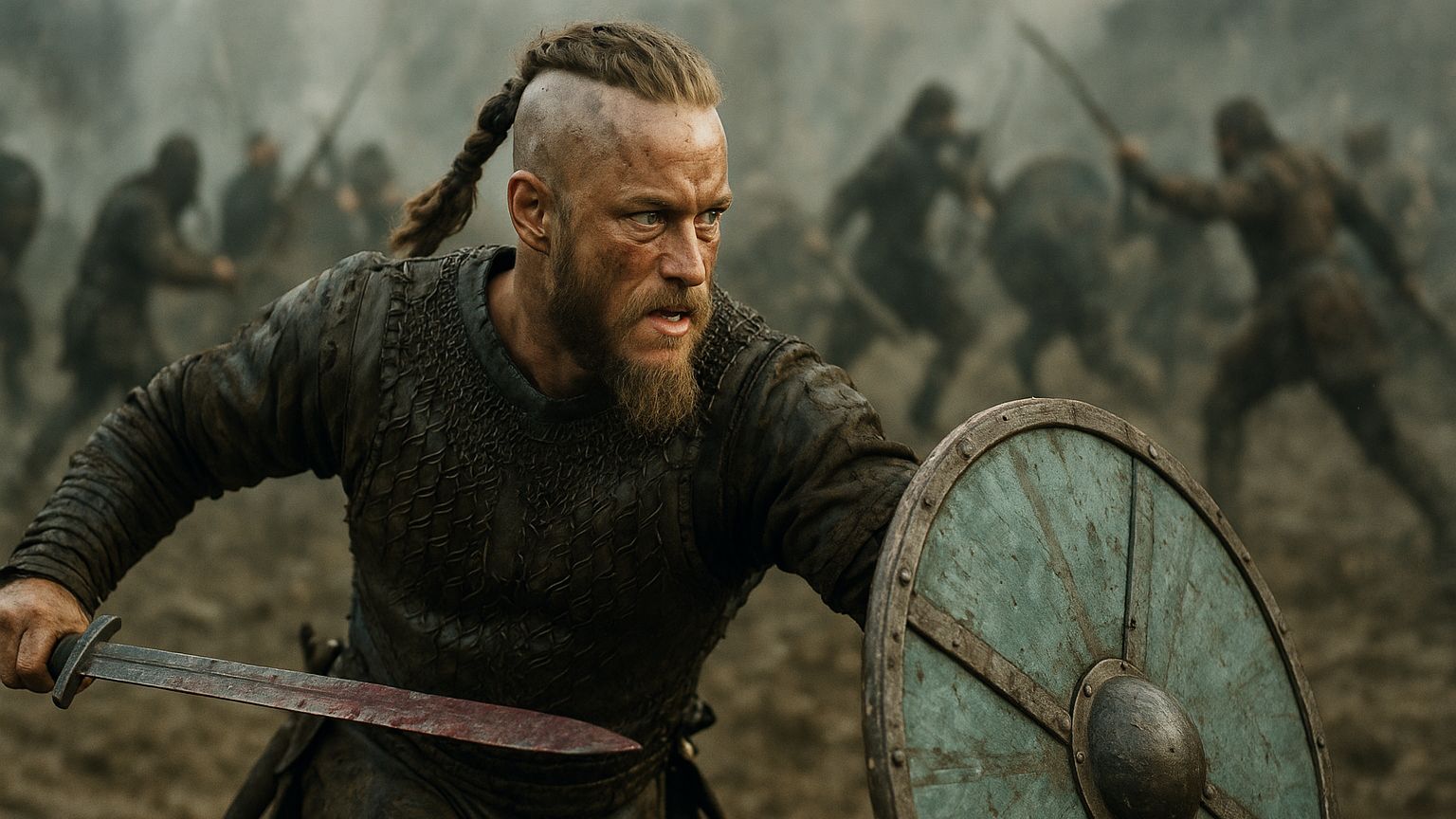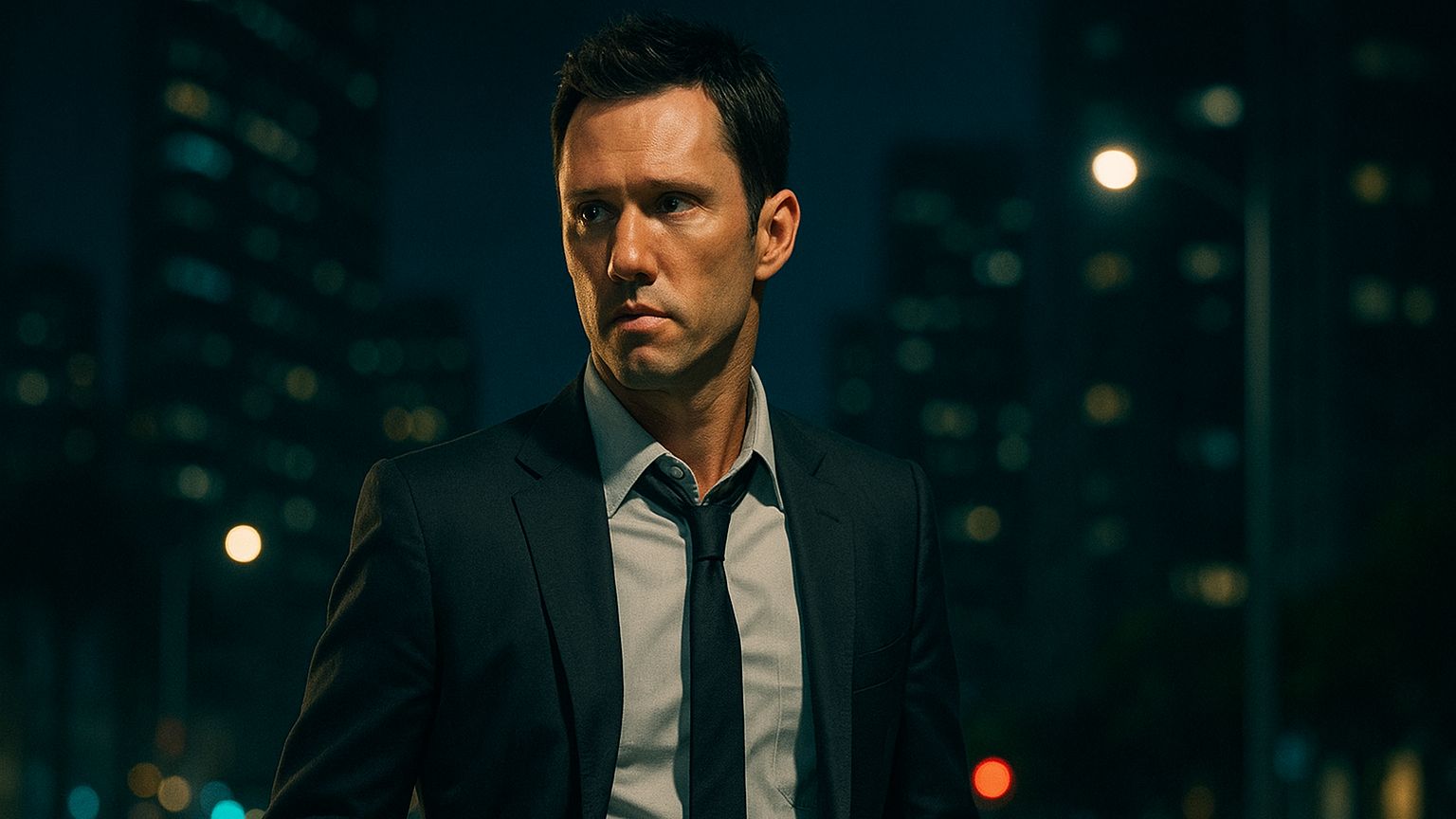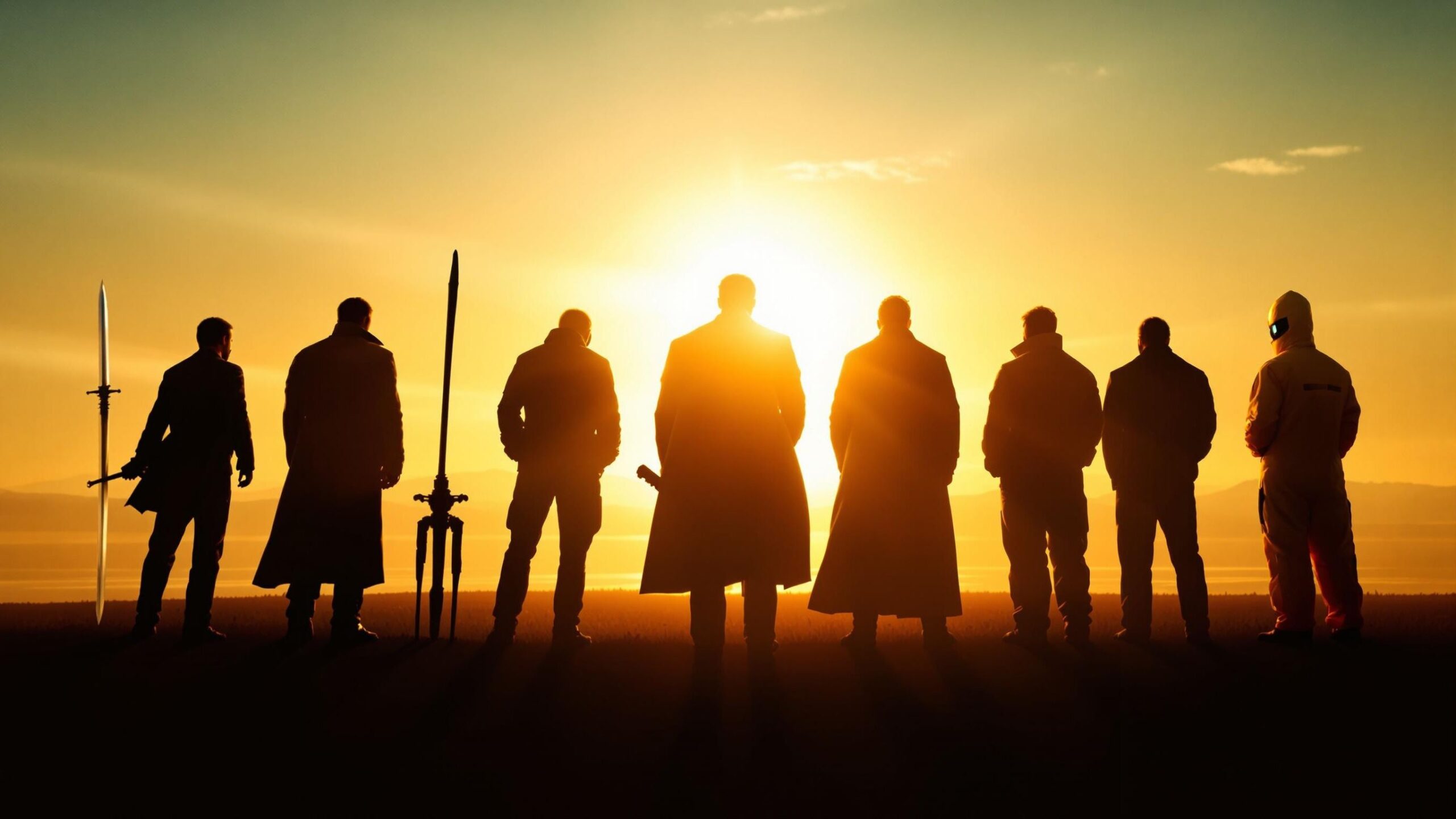Few characters in modern television embody the duality of violence and vision like Ragnar Lothbrok. Introduced as a curious farmer with dreams bigger than the confines of his village, Ragnar quickly becomes a myth in the flesh—a man whose ambition, strategy, and defiance of the gods reshape not only his world but the fate of entire nations. Through war, betrayal, love, and loss, Ragnar rises and falls, yet never ceases to command attention with every word, every silence, every calculated move. His power doesn’t just come from a sword—it comes from the fire in his mind and the depth of his soul. These ten moments capture the sheer magnitude of Ragnar’s legacy, showcasing why he remains one of the most powerful and unforgettable figures in Vikings.
#10: Defying Earl Haraldson in the Thing (Season 1, Episode 3, “Dispossessed”)
One of Ragnar’s first displays of true power comes not from the battlefield, but from a public gathering—The Thing—where he challenges the authority of Earl Haraldson, the reigning ruler. Armed only with words, evidence, and a sharp tongue, Ragnar dares to speak against his leader, accusing him of dishonoring their traditions and hiding the truth about Ragnar’s discovery of new lands to the west.
The moment is electric. The crowd watches in stunned silence as Ragnar does the unthinkable—stand openly against a man who could have him executed. What makes this moment so powerful is the sheer audacity of it. Ragnar doesn’t just question Haraldson’s decisions; he questions his legitimacy. And in doing so, he exposes the cracks in the Earl’s authority for all to see.
This is the first time viewers witness Ragnar wielding power without a sword. His intelligence, charisma, and understanding of Viking law all converge here, turning him from a mere dreamer into a serious political threat. It’s the moment that sets the entire series in motion—the spark that begins Ragnar’s transformation from subject to sovereign.
#9: Killing Earl Haraldson and Claiming Power (Season 1, Episode 6, “Burial of the Dead”)
Words may have started Ragnar’s rise, but steel solidified it. After enduring imprisonment and torture at the hands of Earl Haraldson, Ragnar challenges him to single combat. The duel is brutal, messy, and filled with the primal fury of two men who understand that only one of them will walk away.
The scene is a turning point not just for the plot, but for Ragnar’s identity. As the duel progresses, Ragnar fights with the desperation of a man who has everything to gain and nothing to lose. And when he finally drives the blade into Haraldson, the weight of that victory is seismic. He doesn’t cheer. He doesn’t gloat. He simply kneels beside the body and whispers a prayer—an acknowledgment of the life he just took, and the future he just claimed.
This moment is powerful because it’s both brutal and deeply spiritual. Ragnar doesn’t kill for sport or ego. He kills because it is necessary—for justice, for survival, and for change. In taking Haraldson’s place, Ragnar becomes more than a leader. He becomes a symbol—a man who will fight not just to rule, but to reshape the Viking world.
#8: Letting Athelstan Go (Season 2, Episode 4, “Eye for an Eye”)
In a series defined by violence and conquest, this quiet moment stands out as one of Ragnar’s most profound. After capturing Athelstan again during a raid, Ragnar has the opportunity to keep him in Kattegat forever—to have his friend and spiritual opposite close at hand. But instead, he sets him free, allowing him to return to England and explore his own path.
What makes this moment so powerful is the restraint it shows. Ragnar values Athelstan deeply, not just as a companion, but as a mirror—someone who challenges his beliefs, expands his worldview, and keeps his soul from hardening completely. Letting him go isn’t weakness—it’s strength. It’s a show of emotional maturity that few leaders in Vikings ever display.
This moment also underscores Ragnar’s understanding of power. He knows true loyalty cannot be forced—it must be given freely. And in releasing Athelstan, Ragnar ensures that if their paths cross again, it will be out of trust, not bondage. It’s a quiet but resounding act of leadership, proving Ragnar’s heart is as strong as his sword.
#7: Surviving the Crucifixion (Season 3, Episode 10, “The Dead”)
In one of the most hauntingly powerful moments of Vikings, Ragnar stages his own death—using both deception and near-suicidal endurance—to infiltrate the heart of Paris. After faking a fatal illness and requesting a Christian burial inside the city, Ragnar allows himself to be sealed inside a coffin and delivered through the gates, essentially becoming a Trojan horse. But the most visceral part of the plan occurs before that—when he is strung up, crucified, beaten, and publicly humiliated in front of Frankish crowds to complete the ruse.
He survives. Barely. His body broken, his face bloodied, his breaths shallow—but his mind? Unshaken. This moment encapsulates Ragnar’s unrelenting will and unmatched strategic brilliance. No other character in the series would voluntarily endure so much pain just to gain a tactical edge. And when he finally bursts from the coffin to unleash Viking chaos within the church, the visual of Ragnar—beaten and limping—leading the charge is as mythic as anything in Norse saga.
This moment is powerful because it blends Ragnar’s physical toughness with his genius. He doesn’t just fight battles—he becomes the battlefield. He sacrifices everything, including his dignity and body, for a greater vision. It’s not a brute’s victory—it’s the triumph of a warrior-philosopher willing to suffer for glory and conquest.
#6: Sparing Floki Despite Betrayal (Season 4, Episode 3, “Mercy”)
When Floki, Ragnar’s oldest and most loyal friend, is revealed to be the murderer of Athelstan, the emotional blow to Ragnar is devastating. Their bond, once forged in shared faith and battles, is shattered. Ragnar’s grief and rage are palpable, yet what follows isn’t a swift execution—it’s a prolonged emotional reckoning. He punishes Floki with imprisonment and psychological torment, but eventually, in an act that surprises everyone, he lets him live.
This choice speaks volumes. Ragnar is a man who has slain kings and conquered cities, but in this instance, he chooses mercy—not because Floki deserves it, but because Ragnar needs to show it. He recognizes the complexity of love, loyalty, and betrayal. He sees that executing Floki would be a loss not just of a friend, but of part of himself.
The power in this moment lies in restraint. It shows Ragnar’s growth, his capacity to navigate the storm of personal vengeance versus justice. He doesn’t spare Floki out of weakness—he does it to retain a piece of the humanity he’s been losing. It’s a painful but inspiring glimpse into a man constantly fighting to lead not just with fear, but with conscience.
#5: Converting to Christianity… or Pretending To (Season 3, Episode 10, “The Dead”)
One of Ragnar’s most cunning and controversial moves comes when he seemingly converts to Christianity in front of the Franks. Kneeling in a church, accepting baptism, and whispering prayers with the bishop, Ragnar appears to betray his gods, his people, and his entire identity. Vikings gasp. Viewers rage. Has Ragnar truly abandoned everything?
The answer comes soon after, when Ragnar springs his ambush from within the coffin. The conversion, it turns out, was just another piece of the plan—a masterful act of deception to gain access to the inner sanctum of Paris. But what’s most compelling is that Ragnar never actually tells us if some part of the baptism was genuine. He respected Athelstan. He questioned the gods. The ambiguity lingers.
This moment is powerful because it showcases Ragnar’s unparalleled intellect and ability to play the long game. He understands that perception is power. He’s willing to be hated, doubted, and accused of blasphemy if it means achieving victory. And he’s never clearer in his role as both strategist and showman—someone who doesn’t just conquer with axes, but with ideas.
#4: Confronting King Ecbert About Athelstan’s Death (Season 4, Episode 5, “Promised”)
Ragnar’s relationship with King Ecbert has always been layered—a delicate balance of mutual admiration, manipulation, and subtle threats. But everything changes after the death of Athelstan. The one-man Ragnar trusted beyond his own people is gone, and Ragnar knows—knows—that Ecbert played a role in his demise, even if indirectly. In one of the series’ most quietly devastating confrontations, Ragnar confronts Ecbert alone in his palace, not with rage, but with something more unnerving: restrained, simmering grief.
He doesn’t raise his voice. He doesn’t make accusations. Instead, he speaks with hollow eyes, softly reminding Ecbert of their shared bond through Athelstan. “He loved you,” Ragnar says, and the words carry more weight than any blade. It’s clear that both men feel the loss deeply—but Ragnar’s pain is laced with unspoken blame. The silence between them is thick with meaning, and for a moment, the mighty King of Wessex looks ashamed.
This moment is powerful not because of what’s done, but because of what’s said—and what isn’t. Ragnar could have demanded justice. Instead, he holds a mirror up to Ecbert’s soul and forces him to see the cost of his ambitions. It’s the kind of emotional power few characters can wield, and Ragnar does it with nothing but presence and pain. This scene shows the depth of his love for Athelstan—and his understanding that sometimes, the deepest wounds can’t be avenged, only mourned.
#3: Confessing His Failures to Ivar (Season 4, Episode 15, “All His Angels”)
In the final days of his life, Ragnar Lothbrok shares an intimate moment with his son Ivar the Boneless aboard a small boat bound for Saxon lands. Ragnar is no longer a king, no longer a conqueror. He’s a father, worn and weathered, speaking honestly about his regrets and failures. “I’ve made many mistakes,” he admits, voice low and sincere. “But I want you to know that I’m proud of you.”
It’s the kind of moment most warriors would never allow themselves—a confession not to a god, but to a son. Ragnar strips away his myth and reveals the man beneath: vulnerable, afraid, yet full of love and purpose. He doesn’t try to convince Ivar that the future will be easy—only that he must live, fight, and become greater than the man who raised him.
This moment is powerful because it’s the passing of a torch—not just of power, but of wisdom. Ragnar knows he won’t survive the journey, but he ensures that Ivar carries his name, his strength, and his legend forward. In doing so, he turns personal defeat into generational legacy.
#2: Embracing Death with Dignity (Season 4, Episode 15, “All His Angels”)
Ragnar’s final moment, strung up in a cage in front of King Aelle’s pit of vipers, is not one of weakness—it’s one of total defiance. Bruised, starved, and facing a horrific death, Ragnar looks his enemies in the eye and smiles. His speech—defiant, poetic, and unwavering—is a masterclass in fearlessness. “How the little piggies will grunt when they hear how the old boar suffered,” he declares, seeding vengeance in his sons’ hearts and ensuring that his enemies will know no peace.
What makes this moment legendary is the sheer presence Ragnar commands. He turns his execution into performance, his death into prophecy. He doesn’t beg. He doesn’t break. He becomes eternal. Even King Aelle, full of hatred, looks shaken by Ragnar’s composure.
It’s the final move of a man who lived and died by strategy. By embracing death, Ragnar robs it of its power. And in his final breath, he builds a future of retribution. He turns martyrdom into motivation. And that is the truest expression of Ragnar’s power.
#1: Discovering England and Shaping the Future (Season 1, Episode 8, “Sacrifice”)
Ragnar Lothbrok’s defining moment comes not on a battlefield, but in a revelation. When he first sets sail west and discovers England, he doesn’t just open a new world—he opens a future for his people. While others in Kattegat scoff at his visions, Ragnar sees beyond the horizon. He sees possibilities: of settlement, wealth, trade, and knowledge. His discovery doesn’t just change the course of the series—it alters the course of Viking history.
What makes this moment so powerful is that it’s not just about conquest—it’s about vision. Ragnar is a warrior, yes, but he is also a thinker. He challenges tradition, embraces curiosity, and risks everything for a better tomorrow. That courage—to dream when others demand silence—is what separates Ragnar from everyone else.
As he stands on English soil for the first time, eyes filled with awe and fire, we understand exactly why Ragnar Lothbrok is a legend. Not because he was the strongest. But because he dared to believe that there was more. And then proved it.
Ragnar Lothbrok’s power in Vikings wasn’t just in the blade he carried or the blood he spilled—it was in the dreams he pursued, the empires he defied, and the legacy he left behind. Each of these ten moments reveals a man torn between violence and vision, between destiny and doubt. And yet through it all, Ragnar remained the axis around which the Viking world turned. His choices shaped kings and shattered empires. But most of all, they inspired. Ragnar’s power lives on—not just in memory, but in myth. Because the world didn’t just remember him… it became him.




